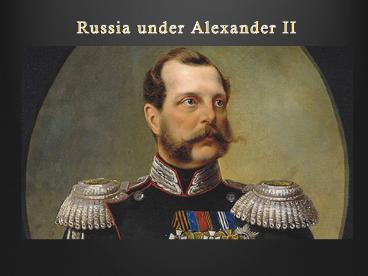Mid-19c European Nationalism - PowerPoint PPT Presentation
1 / 13
Title:
Mid-19c European Nationalism
Description:
... made it difficult for individual peasants to improve agricultural methods or leave their villages Other reforms: Judiciary improved Censorship relaxed ... – PowerPoint PPT presentation
Number of Views:131
Avg rating:3.0/5.0
Title: Mid-19c European Nationalism
1
Russia under Alexander II
2
- Alexander II (1855-1881)
- Perhaps the greatest Czar since Catherine the
Great - Perhaps the most liberal ruler in Russian history
prior to 20th century.
3
- In the 1850s, Tsar Alexander II was an autocrat
whose will was law. - Russias aristocracy continued to own almost all
the land and was exempt from taxes. - Russia had a very small middle class.95 of the
people were peasants, most of whom were serfs.
4
- Serfdom had prevented Russias modernization
agriculture had been poor for centuries - 90 of Russian people worked in agriculture
- Serfdom had led to peasant uprisings, poor
agricultural output, and exploitation of serfs by
lords - Serfs could be bought or sold with or without
land in early 19th century - Serfs could be conscripted into the army for 25
years.
5
- Emancipation Act (or Emancipation Edict), 1861
- Alexander believed ending serfdom was a key to
Russias modernization - Abolished serfdom peasants no longer dependent
on the lord free to move and change occupations
could enter contracts and own property - Most Russians were not impacted by the
Emancipation Edict
6
- Creation of Zemstvos
- In 1864- Alexander introduced a system of local
and regional self-government through elected
assemblies (Zemstvos) - The zemstvos did provide opportunity for public
discussion, they did not lead to the creation of
a national assembly. - Lords controlled the Zemstvos and had more power
than the towns and peasant villages
7
- Most Russians lived in communes which were highly
regulated - Collective ownership and responsibility made it
difficult for individual peasants to improve
agricultural methods or leave their villages - Other reforms
- Judiciary improved
- Censorship relaxed (but not removed
- Education liberalized
8
- Industrialization in Russia was stimulated by
railroad construction - Russia had fallen behind major industrialized
nations in Western Central Europe - Russia needed better railroads, better armaments
and reorganization of the army - Between 1860 and 1880 railroad mileage grew from
1,250 to 15,500
9
- Railroads enabled Russia to export grain and earn
profits for further industrialization - Stimulated domestic manufacturing industrial
suburbs grew up around Moscow and St. Petersburg,
and a class of modern factory workers began to
emerge - Strengthened Russias military giving rise to
territorial expansion to the south and east
10
- Alexander II increasingly turned to more
traditional (conservative) values - Radical populist movement emerged that sought a
utopian agrarian order - Many believed reforms still favored the
aristocracy and did not do enough for the working
classes - Alexander II was assassinated in 1881 by radicals
who bombed his carriage in St. Petersburg
11
Russia under Alexander III
12
Alexander III (r.1881-1894) was committed to the
traditional policies of autocracy, orthodoxy, and
Russification. As tsar, he reversed most of the
liberal changes introduced by his father. He
encouraged anti-Semitic attacks on Jews. He also
weakened the power of the zmestvos (local
administration).
13
Russia strengthened its military, but did not go
to war under his reign. Alexander III was against
foreign influence, especially German. Russia did
continue to industrialize which led to political
problems and the rise of socialism there.































